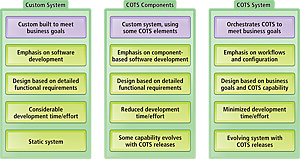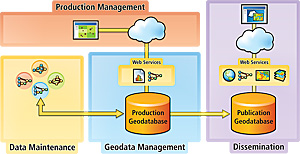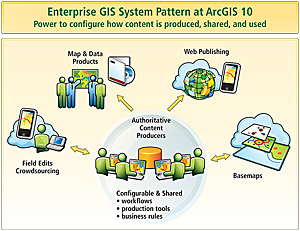The COTS Approach to Enterprise GIS
ArcGIS 10 represents a significant milestone in GIS technology. At version 10, ArcGIS is a complete system for geographic information. It is easier to use and more powerful than previous releases, and it's designed to be pervasive—people can access the system through a variety of clients regardless of their experience with GIS.
With this release, ArcGIS provides the tools, capabilities, and capacity to support enterprise GIS using commercial off-the-shelf (COTS) software. The potential cost savings and improvements to efficiency of a COTS-based system are significant. Esri, through its Professional Services Division, has proved this concept by implementing enterprise GIS for customers using ArcGIS 10 COTS software. The lessons Esri has learned from those real-world experiences are shared here.
Benefits of a COTS Approach
ArcGIS 10 is designed to deliver geographic information via a variety of clients, from the desktop to Web-based and mobile clients, ensuring that everyone who needs the information has access to it without requiring special software or skills. In other words, the delivery of geographic information has been uncoupled from its management, making it possible to configure the system to support multiple departments and business processes without compromising the underlying data. "Simple" and "ready to use" are prevailing principles.
This means that an enterprise GIS is no longer built by stitching together individual software packages but instead is a federated system that can support many different uses. As a result, the user experience can be significantly tailored to each type of user through configuration rather than customization of the system. Users can orchestrate the system to meet the needs of a business or operating unit and, by doing so, bring operational systems online more quickly and for much less expense. The system will then evolve as COTS releases increase its capability over time.

Enterprise GIS systems are built following three basic patterns: custom systems, COTS component systems, and COTS systems. The trade-offs between patterns need to be considered before embarking on a system implementation.
There are a lot of benefits to this approach. Commercial software is developed based on years of working with customers to understand what they need, building in the best practices learned along the way. Implementing a COTS-based enterprise GIS allows organizations to benefit from those best practices rather than reinventing the wheel and creating new processes from scratch. In this way, a system can evolve with the technology, allowing users to benefit from new capabilities as they become available.
The fundamental premise of a COTS approach is to exploit all the power and functionality the commercial software has to offer and implementing that capability as designed. One of the most notable differences a COTS implementation affords over a custom one is the ability to get functionality into the hands of users early and often. By utilizing COTS, much of the functionality is ready for users to exercise quickly. This leads to better acceptance by end users and dramatically improved feedback when compared to the traditional approach of doing a needs assessment and gathering requirements, where end users have less understanding of the capability of the new system. The COTS approach relies on users to provide feedback continually and participate actively in the configuration of the system. Implementation time for a COTS system is significantly reduced because there is no development to be done. Maintenance requires fewer specialized resources—users can leverage standard technical support and a wider labor pool trained in the COTS technology.
A COTS solution will most likely provide the best long-term return on investment (ROI) as well. While the perception may be that it is less expensive to build versus buy, any initial savings are reduced greatly by having to take on responsibility for isolating and correcting any design problems, providing ongoing technical support and training, adapting the product to advances in technology, and providing data migration tools to move data from one release to the next when the product data architecture is modified.
Barriers to a COTS Approach

Implementation time for a COTS system is significantly reduced because there is no development to be done.
COTS-based enterprise GIS may not be the right approach for an organization if its culture, history, and structure won't support it. Taking a COTS approach versus building an enterprise GIS requires fresh thinking, leadership, and agility. The COTS approach is predicated on a focus on business goals instead of a list of detailed feature functions—it puts the emphasis on what the system needs to do, not how the system will do it.
This can be challenging in environments where there is a history of procurements to build custom systems. In large organizations, determining core business requirements is often easier said than done. Internal user groups brought in to help the process often have difficulty separating business requirements from technology or design requirements in their minds.
A COTS approach also asks users to consider new business processes, which can challenge the change management capabilities of an organization. Traditional system procurements often fall into the trap of re-creating old workflows out of new software, usually because people and organizations resist change. It takes leadership, communication, and follow-through to overcome the tendency to stick with the familiar way of doing things.
Even when a system has been proclaimed a COTS implementation, the best intentions of many people often push systems toward customization. Some customization may be required to support particularly complex processes. The trade-offs of custom development, however, must be kept in mind to avoid moving a COTS-based system into a custom- or component-based implementation (COTS modules mixed with custom modules). Many heavily customized COTS systems cannot be easily scaled or extended because there is inadequate design documentation; the technology on which it is based is no longer supported; resources with needed skill sets are no longer available; or the COTS versus custom modules are not clearly delineated, creating dependencies between components that minimize the potential for reuse.
Considering the ROI

ArcGIS 10 provides a COTS platform that supports the major activities required by an enterprise GIS system, including production management, geodata management, data maintenance, and dissemination.
With the advent of ArcGIS 10, GIS technology has matured sufficiently to make COTS-based enterprise GIS implementations feasible, potentially offering significant cost savings and productivity improvements. A COTS system is easier to maintain and allows the system to evolve with new capabilities of the software, ensuring a better ROI in the long run even if the initial costs are more than they would be for building a custom system.
Deciding whether to use COTS or to build a custom enterprise GIS needs to start with an organization's business requirements and should take into account the core competencies, culture, capacity, and capabilities of the organization. If ArcGIS 10 is aligned with an organization's business and technology strategy, it can meet the majority of business requirements, and the organization will use most of the functionality it offers over time, a COTS-based system will be an effective choice.
For more information, contact Brian Cross, department manager, Esri Professional Services (tel.: 909-793-2853, ext. 1-1158; e-mail: bcross@esri.com).
